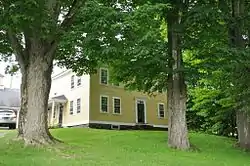Stratton's Inn
Stratton's Inn is a historic house on East Street in Brookfield, Vermont. Built in the late 1790s as a tavern located at the junction of two locally important roads, it is a fine example of Federal period architecture, most importantly preserving the inn's original tap room. It was listed on the National Register of Historic Places in 1982.[1]
Stratton's Inn | |
 | |
  | |
| Location | East St., Brookfield, Vermont |
|---|---|
| Coordinates | 44°2′50″N 72°35′5″W |
| Area | 1 acre (0.40 ha) |
| Built | 1795 |
| Built by | Stratton, Ebenezer |
| Architectural style | Federal |
| NRHP reference No. | 82001703[1] |
| Added to NRHP | July 29, 1982 |
Description and history
Stratton's Inn stands in what is now a remote and rural area of northeastern Brookfield, on the west side of East Street. Just north of the house is a broad bend in the road, from which a former turnpike right-of-way is still discernible, heading southeast. The former inn is a two-story wood frame structure, with a hip roof, large central chimney, clapboarded exterior, and stone foundation. The principal entrance is on the east-facing facade, which is five bays wide. The entrance is framed by slender Federal period pilasters, and is topped by a transom window and corniced entablature. Similar but less elaborate entrances are also found on the south and west sides. A 20th-century three-bay garage is attached at a setback on the south side. The interior of the house follows a fairly typical early Federal central-chimney plan, with a narrow entry vestibule with winding staircase in front of chimney, large chambers on either side, and a long chamber behind. The northern chamber was originally finished as a parlor, while the southern one was the tap room. Near the entrance to the vestibule is a closet, providing access to storage under the stairs, from which it is surmised the tavern host dispensed drinks.[2]
The inn was most likely built sometime between 1795 and 1798 by Ebenezer Stratton, one of Brookfield's first settlers. It was located along what was known as Paine's Turnpike, a major north-south route. It is possible that a sign labelled "E. Stratton's", found in the Smithsonian Museum of American History, originally hung here. The property served as a stagecoach stop at least until 1838, and remained in the hands of Stratton's descendants until 1890, operated mainly as a farm.[2]
References
- "National Register Information System". National Register of Historic Places. National Park Service. July 9, 2010.
- Margaret Delaittre (1981). "NRHP nomination for Strafford Village Historic District". National Park Service. Retrieved 2016-09-11. with photos from 1981